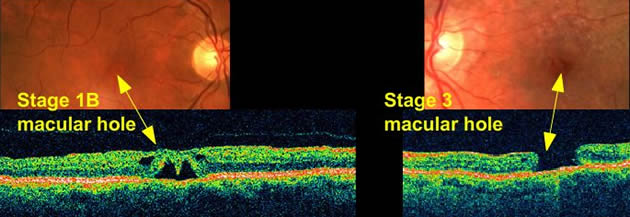Macular Hole
A macular hole is a small break in the macula, located in the center of the eye’s light-sensitive tissue called the retina.
Causes

The eye contains a jelly-like substance called the vitreous. Shrinking of the vitreous usually causes the hole. As a person ages, the vitreous becomes thicker and stringier and begins to pull away from the retina. If the vitreous is firmly attached to the retina when it pulls away, a hole can result.
Most of the eye’s interior is filled with vitreous, a gel-like substance that fills about 80 percent of the eye and helps it maintain a round shape. The vitreous contains millions of fine fibers that are attached to the surface of the retina. As we age, the vitreous slowly shrinks and pulls away from the retinal surface. Natural fluids fill the area where the vitreous has contracted. This is normal. In most cases, there are no adverse effects. Some patients may experience a small increase in floaters, which are little “cobwebs” or specks that seem to float about in your field of vision.
Symptoms
Macular holes often begin gradually. In the early stage of a macular hole, people may notice a slight distortion or blurriness in their straight-ahead vision. Straight lines or objects can begin to look bent or wavy. Reading and performing other routine tasks with the affected eye become difficult. If the hole progresses, a blind spot develops in the central vision and impairs both distance and near activities.

Treatments
Vitrectomy surgery is the most effective treatment to repair a macular hole and possibly improve vision. The surgery involves using tiny instruments to remove the vitreous gel that is pulling on the macula. The eye is then filled with a special gas bubble to help flatten the macular hole and hold it in place while it heals. You must maintain a constant face-down position for one to two weeks after surgery to keep the gas bubble in contact with the macula. A successful result often depends on how well this position is maintained. The bubble will then slowly dissolve on its own.
Do not fly in an airplane or travel to high altitudes until the gas bubble has dissolved. A rapid increase in altitude can cause a dangerous rise in eye pressure.
You can expect some discomfort after surgery. You will need to wear an eye patch for a short time. Your CRC doctor will prescribe eye drops for you and advise you when to resume normal activity.
As the macular hole closes, the eye slowly regains part of the lost sight. The visual outcome may depend on the size of the hole and how long it was present before surgery. Vision does not return all the way to normal.

